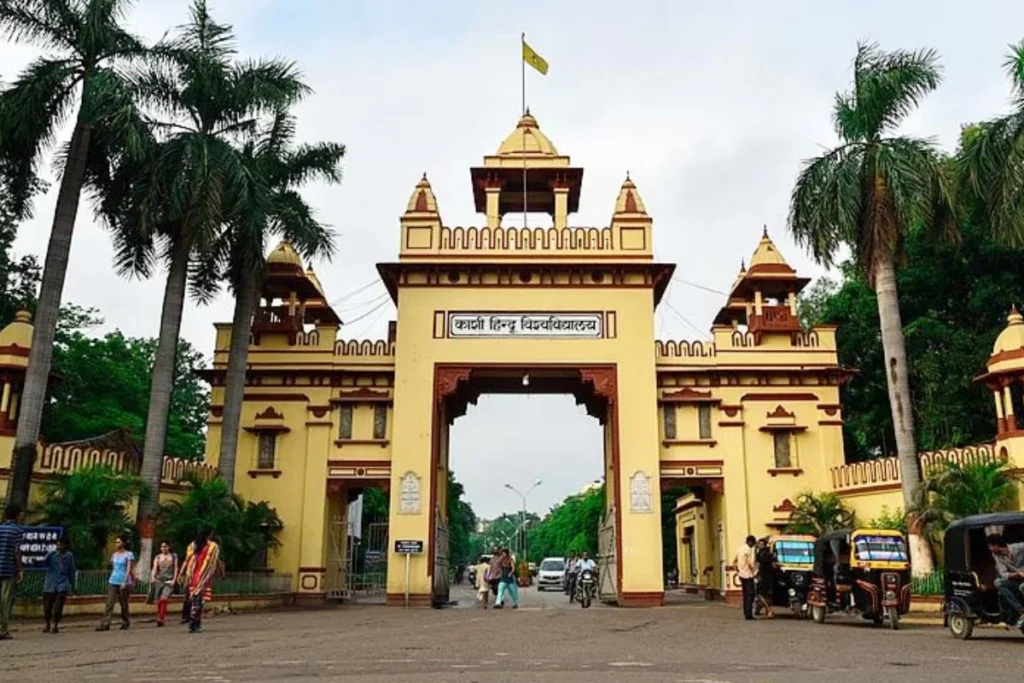Varanasi (Kashi), Ayodhya & Prayagraj Tour
- 4 Nights & 5 Days Religious Tour
Welcome to Nimantran India Tour
Thank you for showing your interest in our Rituals Tour Package. We are thrilled to introduce you to our travel company, Nimantran India Tour, located in Varanasi, India. With a team of professionals and extensive experience, we specialize in organizing private and tailor-made holidays across India and the subcontinent.
Our top priority is to guide you seamlessly through the planning of your holiday. At Nimantran India Tour, we offer adventurous tours, honeymoon tours, and family tours, ensuring you have the best experience. Our packages include all types of transportation, accommodations, and ticket bookings (flights and trains) when needed. Our skilled guides and drivers ensure a comfortable journey. North India, with its vibrant cultural heritage, is truly a land of “Unity in Diversity.” Avail an exclusive 4 Nights & 5 Days Tour Package to Varanasi, Ayodhya, and Prayagraj.
Ask For Free Quote!
Day 1: (arrival at varanasi)

Ganga Aarti: 6:00 PM to 6:45 PM
Upon arriving at Varanasi Airport or Railway Station, you’ll be transferred to your pre-booked hotel. After freshening up, witness the mesmerizing Ganga Aarti from 6:00 PM to 6:45 PM. This sacred ritual is performed by 7 priests on the Ghats, accompanied by enchanting mantras and bhajans that honor the river Ganga, Kashi Vishwanath, and Hari Vishnu. The sight is believed to cleanse the soul, with a boat ride offering a unique perspective of this divine ceremony. The atmosphere, filled with spirituality and devotion, is an unforgettable experience. After the Aarti, return to your hotel for an overnight stay, embracing the peaceful essence of Varanasi.
Day 2: (Varanasi tour)

Kashi Vishwanath Temple
Begin your day with a visit to the sacred Kashi Vishwanath Temple, one of India’s most revered Hindu shrines. This temple is one of the twelve Jyotirlingas, dedicated to Lord Shiva in the form of Vishwanath or Vishweshwara, meaning “Ruler of the Universe.” The temple is situated on the western bank of the Ganges and holds immense significance for those seeking moksha (salvation). Pilgrims believe that offering prayers here leads to spiritual liberation. Dating back to ancient times, the temple stands as a symbol of spirituality and devotion. The surroundings echo with the sounds of prayers, and the aura is filled with devotion and tranquility. As you exit, explore the vibrant streets of Kashi filled with shops selling traditional offerings.

Annapurna Mandir
Located in the heart of Varanasi, Annapurna Mandir is dedicated to Goddess Annapurna, the deity of nourishment. The temple, built by Maratha Peshwa Bajirao in the 18th century, is a significant pilgrimage site in Hinduism. According to mythology, Goddess Annapurna is considered the provider of food, symbolizing abundance and prosperity. Devotees believe that praying here blesses them with the fulfillment of their material and spiritual needs. The temple features a magnificent idol of the goddess holding a golden ladle, symbolizing her role in providing sustenance. The rituals here include special offerings of cooked food, representing gratitude for nourishment. The temple’s ambiance, filled with chants and devotional music, enhances the experience, making it a meaningful spiritual destination.

Vishalakshi Temple
Visit the Vishalakshi Temple, a sacred Shakti Peetha in Varanasi. Located near Mir Ghats on the banks of the Ganges, it is dedicated to Goddess Vishalakshi, an incarnation of Parvati known for her expansive eyes (Vishal means big, and akshi means eyes). The temple holds immense spiritual importance as one of the triad of Shakti Peethas, along with Kanchi Kamakshi and Madurai Meenakshi. It is believed that visiting these temples fulfills the desires of devotees and grants spiritual energy. The temple’s architecture showcases intricate designs, reflecting ancient artistry. Devotees often offer traditional sweets, flowers, and vermilion to the goddess. The serene ambiance of the temple provides a peaceful retreat, making it a vital stop on the Varanasi spiritual circuit.

Sankat Mochan Hanuman Temple

Banaras Hindu University (BHU)
Founded in 1916 by Pandit Madan Mohan Malaviya, Banaras Hindu University (BHU) is a prominent educational institution in India. Spread across 1,300 acres, BHU is not only known for its academic excellence but also its contribution to preserving Indian culture and spirituality. The campus is adorned with beautiful buildings, lush gardens, and statues of renowned leaders, adding to its serene ambiance. It hosts the Vishwanath Temple, a modern replica of the Kashi Vishwanath Temple, attracting both students and pilgrims. The university encourages creativity and research, offering a variety of disciplines. A stroll through BHU’s campus allows visitors to appreciate its historical significance and the role it plays in nurturing India’s intellectual and spiritual growth.

Sarnath
Located 10 km from Varanasi, Sarnath is the place where Gautama Buddha delivered his first sermon after attaining enlightenment at Bodh Gaya. It marks the birth of the Buddhist Sangha, where Buddha shared his teachings with his first five disciples. The site includes the Dhamek Stupa, built by Emperor Ashoka in 249 BCE, symbolizing the “Turning of the Wheel of Dharma.” Other attractions include the Ashoka Pillar, the Sarnath Museum, and the Mulagandha Kuti Vihar Temple, which houses ancient relics and murals depicting Buddha’s life. Sarnath holds immense spiritual and historical value, making it a revered destination for both Buddhist pilgrims and tourists. The peaceful ambiance of the site invites meditation and introspection.
Day 3: Varanasi-Prayagraj-Varanasi

Triveni Sangam
The Triveni Sangam is the confluence of three sacred rivers: the Ganges, Yamuna, and the mythical Saraswati, located in Prayagraj. It is considered a highly auspicious site for Hindus, symbolizing the spiritual union of these rivers. Pilgrims believe that bathing at this confluence cleanses sins and grants moksha (salvation). The serene waters and religious rituals create a peaceful atmosphere, drawing visitors throughout the year, especially during the Kumbh Mela. The surrounding area is filled with the sounds of prayers, and devotees often offer rituals for ancestors, adding a deeply spiritual essence. After experiencing this sacred spot, visitors can enjoy the local delicacies from nearby stalls before returning to Varanasi.

Alopi Devi Temple
The Alopi Devi Temple holds a unique place among the sacred temples of Prayagraj. It is dedicated to Alopi Devi, known as the ‘vanished virgin goddess.’ According to legend, the temple emerged at the site where a bride mysteriously vanished during a wedding procession, leading locals to worship her as a deity. Devotees visit the temple to seek blessings for life events such as marriages, births, and new beginnings. The temple’s architecture is simple, reflecting its ancient origins, yet the spiritual energy felt here is profound. Festivals and rituals at Alopi Devi Temple attract devotees from across the region, enriching Prayagraj’s cultural and religious heritage.

Akshayavata Tree
The Akshayavata Tree, located within the Patalpuri Temple at Prayagraj Fort, is considered sacred in Hindu mythology. The tree is believed to be immortal, with its roots linked to ancient texts that describe it as indestructible. Devotees visit the Akshayavata to offer prayers for longevity and spiritual growth. Legends suggest that even during the great flood, this tree remained unscathed, representing resilience and eternal life. The Patalpuri Temple, where the tree resides, is one of the oldest temples in India, adding to the historical significance of this site. Visiting this sacred tree provides a glimpse into Prayagraj’s rich spiritual heritage and timeless devotion.

Laying Hanuman Temple
The Laying Hanuman Temple, also known as Bade Hanuman Mandir, is one of the most iconic landmarks in Prayagraj. This unique temple features a massive reclining idol of Lord Hanuman, situated six to seven feet below ground level in an underground pit. According to mythology, Hanuman rested here after burning Lanka, with his idol partially submerged in the Ganges during monsoons. It is believed that touching the idol’s feet brings good luck and removes obstacles from life. The temple remains crowded with devotees, especially on Tuesdays and Saturdays. The divine aura and the serene surroundings make it a significant spiritual destination, before returning to Varanasi.
Day 4: Varanasi-Ayodhya-Varanasi

Ram Mandir
The Ram Mandir in Ayodhya, located at Ram Janmabhoomi, is one of the holiest sites for Hindus. It marks the birthplace of Lord Rama, a central figure in Hindu mythology. Currently under construction, this grand temple is supervised by the Shri Ram Janmabhoomi Teerth Kshetra trust. The temple will feature intricate architecture, showcasing traditional Hindu designs. Pilgrims flock to offer prayers and participate in rituals, believing it brings blessings and spiritual fulfillment. The serene ambiance and devotion of visitors create a powerful spiritual experience. As a major pilgrimage destination, the temple symbolizes Hindu faith, attracting believers from around the world seeking divine blessings.

Ramkatha Museum
The Ramkatha Museum in Ayodhya is dedicated to the life and legacy of Lord Rama. It showcases a collection of artifacts, paintings, and exhibits related to Ramayana’s historical and cultural significance. The museum’s displays offer a comprehensive understanding of the Ramayana’s teachings, highlighting events from Lord Rama’s birth to his victory over Ravana. Visitors can also see ancient manuscripts, sculptures, and models depicting Ramayana scenes. Interactive audio-visual presentations make it engaging for tourists, offering insights into the epic’s moral values and ideals. The museum adds depth to Ayodhya’s spiritual journey, making it an essential stop for those seeking cultural immersion and enlightenment.

Hanumangarhi
The Hanumangarhi Temple is a prominent religious site in Ayodhya dedicated to Lord Hanuman. According to legend, Hanumanji guards the Janmabhoomi of Lord Rama from this location. Perched atop a hill, visitors climb 76 steps to reach the temple, symbolizing the spiritual journey toward devotion and faith. The temple houses a large idol of Hanuman along with his mother, Anjani, offering blessings to devotees. Believers visit to seek Hanuman’s divine protection and fulfillment of wishes. The temple is crowded during Tuesdays and Hanuman Jayanti, creating an atmosphere filled with chants and prayers. It is an essential destination for those exploring Ayodhya’s spiritual essence.

Kanak Bhavan
The Kanak Bhavan in Ayodhya is a beautiful palace-like temple dedicated to Goddess Sita and Lord Rama. It is believed that this temple was gifted to Sita by Rama’s stepmother, Queen Kaikeyi, after their wedding. The architecture features ornate designs with carved pillars, arches, and domes, symbolizing the grandeur of ancient Indian craftsmanship. The main sanctum houses charming idols of Rama and Sita, adorned with gold crowns, symbolizing divine love and devotion. Devotees believe that offering prayers here ensures marital bliss and family harmony. The peaceful ambiance, combined with devotional music, creates a serene environment, making it a cherished destination for pilgrims.







